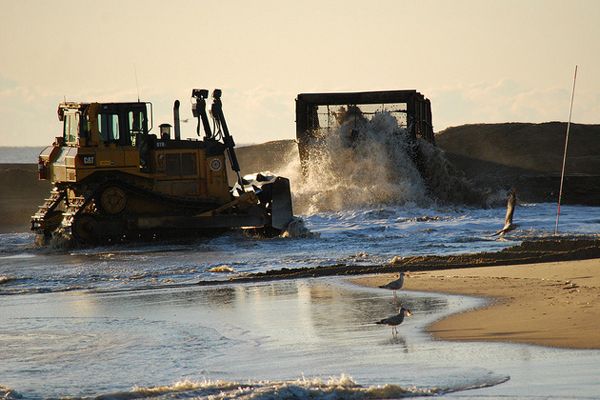When 'Suckers' Rebuild Eroding Beaches, 'Free Riders' Benefit

(ISNS) -- What do you call a coastal town that keeps spending millions of dollars on bringing sand to rebuild its eroded beaches?
According to scientists at the University of North Carolina Wilmington, "sucker" is the appropriate term. And towns up and down the nearby coast which spend nothing can be called "free-riders."
The two terms, which come from sociology and economics, not geology, describe what happens in a computer model the scientists developed when one town spends money on renourishing its beaches by bringing in sand and helps nearby towns that don't.
Because the model shows that the new sand improves the beach -- and property values -- the sucker town keeps bringing in more sand while the free-riders get improved beaches without spending a dime, which creates a fiscal feedback loop.
"Towns along the coast are free-riding on the suckers who are supplying them with nourishing sand," said Zach Williams a physical oceanographer at UNC-Wilmington. "As erosion increases, it becomes locally optimal to nourish more. Property values need to be stabilized."
Williams and colleagues, including scientists at Duke and Ohio State Universities, published the results of their model in the current issue of the Journal of Geophysical Research: Earth Surface.
The model does not use actual data from coastal towns, mostly because the data do not exist, Williams said. They modeled what they knew about the North Carolina coast extended it to East Coast sand beaches.
Sign up for the Live Science daily newsletter now
Get the world’s most fascinating discoveries delivered straight to your inbox.
Because the effects shown in the model stretch over years, it is impossible to know how accurate the model is.
"We don't expect that at this second that there are full-blown sucker feedbacks taking effect," Williams said. The effects can take as long as 40 years to be seen in the real world.
The model assumes for the experiment that all the towns along the coast they modeled are alike economically -- no towns are rich, none are poor. That way, the model could concentrate on the physical effects of erosion and renourishment.
Sand naturally is washed up and down the coast by ocean action, waves and currents. When one town renourishes its beach, the ocean moves the sand up and down the coast, extending the beaches of other towns which did not bring in more sand, the model showed.
The town paying for the new sand sees enough benefit to keep bringing in more, and the other towns see erosion on their beaches mitigated and have little inclination to start spending their own money. This gets amplified in the model because sand is getting increasingly more expensive; sand is not an infinite resource, Williams said.
In the long run, the model shows, the renourishing town, the sucker in this analogy, passes a point of diminished return -- more money producing less improvement -- and property values in the town decrease. In the model, which runs for 150 years' time, it would actually be possible to get a negative value to the property, but Williams admits that never happens in the real world because the federal government steps in with subsidies.
Modeling studies such as this need to be taken with a grain of salt, some scientists believe. The not-infrequent differences between models and the real world illustrate a growing schism in science, between scientists working in the field and those at computers developing data-making models -- in other words, scientists who are sure they are seeing the trees and those who think they can describe the forest. The two sides even have their own journals.
According to Orrin Pilkey, a professor emeritus of earth and ocean sciences at Duke who was not part of Williams' experiment, the real world is more complicated than the model.
"In my experience, storms are mainly responsible for nourishing beaches," he said. The Wilmington model assumes it is caused by uniform wave action. Additionally, much sand transport occurs offshore, farther out than assumed by the model.
Not all communities are equal, an assumption in the model, Pilkey said, which affects the economics. Also, single towns often contain pockets that are richer or poorer than their neighbors. But, in his experience with the issue, the choice to add sand to one beach over another can be reduced to politics, not science.
"It's politics [that] so much determines which beach will get renourished and which doesn't," Pilkey said.
"Politics erases everything on the coast," he said.
Joel Shurkin is a freelance writer based in Baltimore. He is the author of nine books on science and the history of science, and has taught science journalism at Stanford University, UC Santa Cruz and the University of Alaska Fairbanks.
Inside Science News Service is supported by the American Institute of Physics.











